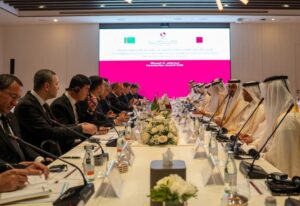Qatar’s Renewable Energy Production Set to Rise Significantly by 2030

Doha, The Gulf Observer: Qatar’s renewable energy production currently stands at 5 percent of the total energy mix but is forecast to rise to 18 percent by 2030, according to Eng. Abdul Rahman Ibrahim Al Baker, Director of Production Planning and Business Development at Kahramaa, in an interview with Qatar News Agency.
Al Baker underscored the crucial role of renewable energy in achieving the goals outlined in the National Development Strategy 2024-2030. The Qatar National Renewable Energy Strategy aims to develop a sustainable and cost-effective energy system, leveraging the country’s abundant natural gas reserves and renewable energy potential.
The strategy aims to generate 4 gigawatts from centralized renewable energy projects and 200 megawatts from distributed projects by 2030. It focuses on three main goals: reducing carbon dioxide emissions through sustainable policies, increasing the share of renewable energy while maintaining grid reliability, and maximizing the social and economic benefits of renewable energy programs.
Al Baker highlighted the competitive costs of renewable technologies, making adoption more attractive in Qatar and the region. The cost of photovoltaic solar energy has dropped from around 4 cents per kilowatt-hour in 2017 to about 1.5 cents in 2023, with expectations to decrease to around 1 cent per kilowatt-hour by 2030. Similarly, the cost of wind energy has decreased from about 5 cents per kilowatt-hour in 2017 to approximately 4.5 cents in 2023, projected to reach about 4 cents per kilowatt-hour by 2030. The recommended energy mix is expected to reduce the average cost of electricity generation by 15 percent in 2030.
The strategy will enhance energy security by diversifying energy sources, ensuring the stability of the energy sector. It adopts a balanced approach, combining centralized renewable energy facilities with high-efficiency gas-powered thermal generation.
Qatar’s high potential for increasing renewable energy usage is due to the high quality of its solar energy resources, with a global horizontal irradiance averaging over 2,000 kilowatt-hours per square meter annually. The strategy focuses on photovoltaic solar technology due to its mature status and the presence of numerous specialized companies in this field.
Currently, renewable energy production in Qatar is distributed between the Siraj 1 PV solar plant in Al Kharsaah with a capacity of 800 megawatts and over 9 megawatts from distributed solar projects. The country’s energy mix predominantly relies on thermal generation, with a total thermal power capacity exceeding 12 gigawatts, accounting for over 90 percent of the country’s total power generation capacity.
Al Baker acknowledged challenges such as the limited capabilities of the private sector in contributing effectively to large projects and the need for significant investments estimated at $7.6 billion by 2030. To overcome these challenges, he emphasized the importance of building skills and capabilities, assessing the attractiveness of the renewable energy manufacturing sector, and considering financial enablers if necessary.
The strategy proposes launching a net billing mechanism to encourage investments in distributed solar projects, coordinating with financial institutions like Qatar Development Bank to offer attractive financing programs, and streamlining the application process through effective coordination with the Ministry of Municipality. Additionally, establishing clear technical standards and regulations, offering affordable vocational training programs, and activating a supportive strategy for renewable energy tenders are key elements.
The Qatar General Electricity and Water Corporation (Kahramaa) announced the launch of the Qatar National Renewable Energy Strategy in late April, aimed at diversifying and increasing the use of renewable energy sources, particularly solar energy. The strategy reflects Qatar’s commitment to a sustainable future, aligning with Qatar National Vision 2030 and the National Development Strategy 2024-2030.


